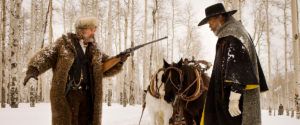
The Hateful Eight
4 Stars- Director
- Quentin Tarantino
- Cast
- Samuel L. Jackson, Kurt Russell, Jennifer Jason Leigh, Walton Goggins, Demián Bichir, Tim Roth, Michael Madsen, Bruce Dern, Channing Tatum, Zoë Bell, James Parks
- Rated
- R
- Runtime
- 182 min.
- Release Date
- 12/25/2015
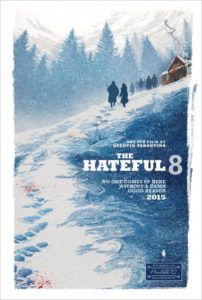
In the opening credits of The Hateful Eight, the filmmaker Quentin Tarantino reminds us this is his “Eighth Film” since his 1992 debut with Reservoir Dogs. Since then, audiences have been treated to a distinctive voice in cinema. Tarantino’s rare ability to recycle and refurbish ideas from the films of the 1960s and 1970s, yet make them his very own, have branded his films as unique, however familiar they may be. Influential and innovative in his derivations, he’s like a filter through which old material becomes bolstered for a new generation of cinephiles. The Hateful Eight pays homage to Westerns and chamber mysteries, being a tight-quartered yarn populated by memorable characters. Tarantino explores territory that may seem like the offspring of Reservoir Dogs and Django Unchained; however, there is far more wit, ingenuity, and cinematic beauty here—enough to rank it above those titles and others on his oeuvre. Shooting talented actors performing his sharp dialogue on 70mm cameras, Tarantino achieves a confidently made celebration of formal beauty within his grisly, often hilarious, and certainly confrontational film.
The Hateful Eight’s long, difficult journey to the screen has been the subject of much of the film’s publicity—along with opening up against Star Wars: Episode VII – The Force Awakens, it’s an underdog in that way. Its rugged trail began shortly after Django Unchained when Tarantino announced he was working on another Western. The post-modern innovator originally intended the film to be a sequel to his controversial “Southern” from 2012, but he soon developed the script as a beast all its own. Production was set to begin in late 2014, but earlier that year one of the few individuals he had given the script leaked it online. Upset about the leak and having failed in his attempt to sue the website that posted it, Tarantino was somewhat disenchanted about filming the leaked script; he even considered publishing it and scrapping the film altogether. After the director hosted a staged reading at Los Angeles’ Ace Hotel Theater and received enthusiastic responses, he resolved to film The Hateful Eight after all, rewriting the story’s final act to allow some level of secrecy and surprise for audiences. With a $40 million budget, shooting began on January 7, 2015, in Wilson Mesa in the Colorado Rockies over a cold winter, while many of the film’s interior shots were filmed on chilled studio sets.
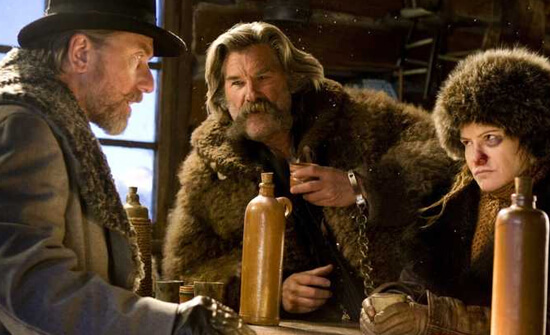 After production wrapped, the problems for The Hateful Eight continued. Tarantino’s decision to shoot in 70mm, specifically Ultra Panavision 70, which was last used on Khartoum in 1966, would mean added expense to distributors at The Weinstein Company, but also made problems for cinemas. The expensive yet gorgeous process, overseen by Tarantino’s longtime cinematographer Robert Richardson, allows for an incredible amount of detail and beauty. But it also required TWC to equip 98 cinemas around the U.S. with 70mm projectors. Early critics screenings complained of the projectors going in and out of focus, as most projectionists deal with digital files rather than film stock today—and even then, it’s not 70mm film stock. Elsewhere, TWC had allegedly negotiated a deal with Arclight Theaters to project The Hateful Eight on their massive Cinerama Dome, but Disney, distributors of The Force Awakens, threatened to pull the latest Star Wars moneymaker from all Arclight Theaters unless the Hollywood location show their film on the Cinerama Dome. Understandably, Tarantino took it personally.
After production wrapped, the problems for The Hateful Eight continued. Tarantino’s decision to shoot in 70mm, specifically Ultra Panavision 70, which was last used on Khartoum in 1966, would mean added expense to distributors at The Weinstein Company, but also made problems for cinemas. The expensive yet gorgeous process, overseen by Tarantino’s longtime cinematographer Robert Richardson, allows for an incredible amount of detail and beauty. But it also required TWC to equip 98 cinemas around the U.S. with 70mm projectors. Early critics screenings complained of the projectors going in and out of focus, as most projectionists deal with digital files rather than film stock today—and even then, it’s not 70mm film stock. Elsewhere, TWC had allegedly negotiated a deal with Arclight Theaters to project The Hateful Eight on their massive Cinerama Dome, but Disney, distributors of The Force Awakens, threatened to pull the latest Star Wars moneymaker from all Arclight Theaters unless the Hollywood location show their film on the Cinerama Dome. Understandably, Tarantino took it personally.
Aside from being overshadowed by The Force Awakens (along with every other release in the 2015 holiday season), the film’s distribution has been broken into two distinct debuts. On December 25, 2015, in select theaters, The Hateful Eight appeared in a “Roadshow Engagement” (the version on which this review is based), while on December 31, the film will be released everywhere else in digital projection. The Roadshow Engagement is several minutes longer than the digitally projected version and contains some alternate cuts of exterior scenes that make the most of the 70mm presentation; it also contains a complete overture and intermission. Nevertheless, hope for a breakout success was further hindered when, only days before the film’s release, a DVD screener of The Hateful Eight belonging to producer Andrew Kosove, co-CEO of Alcon Entertainment and producer of the Point Break remake, was leaked online to nearly a million downloads within a few days.
Tarantino’s bad luck surrounding the development and distribution of The Hateful Eight is even more disheartening because the film is astounding and demands to be seen in theaters. Drawing from Western television shows such as Bonanza and The Virginian, the filmmaker creates a bloody chamber drama in which no one is who they seem—just like one of those classic episodes where everyone’s holed-up for a night and forced to discover each others’ secrets. Through the course of a breezy three-hour runtime, we learn the duplicitous motivations of these characters as they interact in a mountain lodge during a snowstorm. The film opens on a snowy trail in the mountains with a private stagecoach carrying bounty hunter John “The Hangman” Ruth (Kurt Russell, sporting the same impressive mustache from Bone Tomahawk) and his bounty, Daisy Domergue (Jennifer Jason Leigh), who has a $10,000 price on her head. Ruth earned his nickname because he believes in law, and America, both to a fault. His motto: “You only need to hang mean bastards, but mean bastards you need to hang.” In the mountains, the stagecoach stops for a stranded traveler, Major Marquis Warren (Samuel L. Jackson), another bounty hunter with a pile of three bodies he’s delivering in the town of Red Rock. After some tough negotiating, Warren convinces Ruth to allow him aboard the stage.
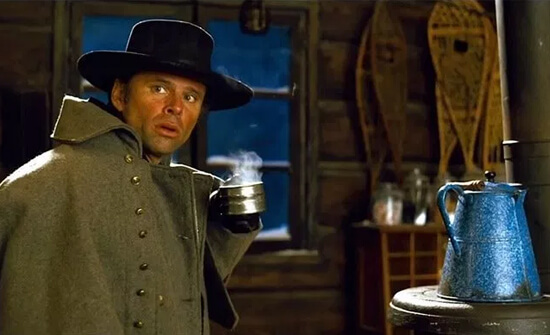 With a blizzard quickly approaching, the stage won’t make it to Red Rock, where Ruth too must go to watch Daisy hang. Instead, they head toward a frontier post called Minnie’s Haberdashery to take shelter. Though Ruth and Warren know each other, Ruth remains ever-suspicious, especially when former rebel soldier Chris Mannix (Walton Goggins) appears on the trail, also in need of a ride. Mannix claims to be the future Sheriff of Red Rock, yet his family history suggests he could never be a lawman. When the foursome arrives at Minnie’s, they find the watering hole populated by four others: Bob the Mexican (Demian Bichir) has been temporarily placed in charge while, according to him, Minnie is visiting her mother; lowly “cow puncher” Joe Gage (Michael Madsen) claims to have been caught in the storm while on his way to visit his mother for Christmas; talkative British dandy Oswaldo Mobray (Tim Roth) is soon to be Red Rock’s new hangman; and Confederate General Sandy Smithers (Bruce Dern) rests his weary bones in a chair by the fire. Ruth holds onto his suspicion that everyone is either after his bounty or in league with Daisy. And yet, he remains a mean bastard who doesn’t hesitate to strike if Daisy talks (“I want us to work out a signal system of communication,” he tells her after delivering a blow to her face. “Like when I elbow you real hard in the face, that means shut up.”). Meanwhile, Warren is a man of color in a room with at least two former Confederates. And having fought against Smithers during the Civil War, he takes exception to the General’s crimes against his race.
With a blizzard quickly approaching, the stage won’t make it to Red Rock, where Ruth too must go to watch Daisy hang. Instead, they head toward a frontier post called Minnie’s Haberdashery to take shelter. Though Ruth and Warren know each other, Ruth remains ever-suspicious, especially when former rebel soldier Chris Mannix (Walton Goggins) appears on the trail, also in need of a ride. Mannix claims to be the future Sheriff of Red Rock, yet his family history suggests he could never be a lawman. When the foursome arrives at Minnie’s, they find the watering hole populated by four others: Bob the Mexican (Demian Bichir) has been temporarily placed in charge while, according to him, Minnie is visiting her mother; lowly “cow puncher” Joe Gage (Michael Madsen) claims to have been caught in the storm while on his way to visit his mother for Christmas; talkative British dandy Oswaldo Mobray (Tim Roth) is soon to be Red Rock’s new hangman; and Confederate General Sandy Smithers (Bruce Dern) rests his weary bones in a chair by the fire. Ruth holds onto his suspicion that everyone is either after his bounty or in league with Daisy. And yet, he remains a mean bastard who doesn’t hesitate to strike if Daisy talks (“I want us to work out a signal system of communication,” he tells her after delivering a blow to her face. “Like when I elbow you real hard in the face, that means shut up.”). Meanwhile, Warren is a man of color in a room with at least two former Confederates. And having fought against Smithers during the Civil War, he takes exception to the General’s crimes against his race.
Somewhat contrary to the sheer monumentality of Ultra Panavision 70, the same format that was used to film the iconic chariot race in Ben-Hur (1959), The Hateful Eight proceeds as a claustrophobic chamber mystery—something akin to an Agatha Christie whodunit. The director breaks up the action over six chapters, as his characters settle in for a series of tense interactions and beautifully written exchanges of dialogue, each of which reveals more about their backstories, more about their lies, and leads to bursts of bloody violence. Much like Inglourious Basterds‘ excruciatingly suspenseful scene in the basement of a German bar, Tarantino reserves his violence and the tension for almost longer than we can endure, just before the intermission. After the break, Tarantino himself (speaking in voiceover) catches us up with what happened in the interim. He even takes us back, way back, to what happened at Minnie’s before Ruth’s stagecoach arrived, ratcheting up the suspense even further.
Top-billed, Jackson steals the show, despite Russell’s joyously bombastic turn as a roguish John Wayne character. Ever since Jackson has, at times, become a self-parody by fighting reptiles on aircraft and assembling superheroes, he doesn’t seem to try much; Tarantino may be the only filmmaker consistently challenging Jackson to demonstrate his acting chops. The actor is slippery, hilarious, and chews the scenery more even than the rest of Tarantino’s ensemble. Russell and Leigh offer wonderful performances, the former with a hint of “hurt feelings” in one scene and the latter with an unapologetically cruel streak. Goggins, too, stands out as a dopey and ultimately honorable sort. But then, there’s not one false performance in the bunch. Newcomers to Tarantino’s work like Bichir, Leigh, and a cameo by Channing Tatum pair nicely with familiar faces like Madsen, Roth, Dern, and Zoë Bell. All of them inhabit the lodgings well and deliver unforgettable performances, bringing the director’s dialogue to life.
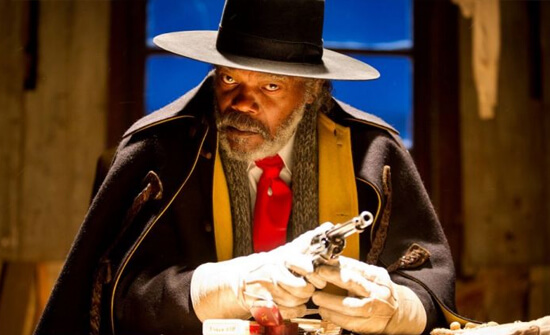 Adding to the film’s Western appeal, Tarantino convinced legendary composer Ennio Morricone to write his first Western score since 1975’s A Genius, Two Partners and a Dupe. Although Morricone contributed segments of music for earlier Tarantino works such as Inglourious Basterds, this is his first full score for the director. Of course, Tarantino uses a post-modern injection of period-inappropriate music (from Roy Orbison and The White Stripes, among others), much as he’s done in his other historical pictures. And where the 87-year-old composer could not complete his work, he allowed Tarantino access to unused pieces from his score on John Carpenter’s The Thing (1982)—effective music for another clear influence on The Hateful Eight, from its wintry setting to its And Then There Were None-like scenario. Elsewhere, Tarantino’s attention to detail enhances the aural experience. When characters are riding in the coach, for example, the director includes an audio track of the driver (James Parks, playing the likable O.B., by no means hateful) horsewhipping the six-horse team. Inside the haberdashery, the sound of the blizzard outside never lets up.
Adding to the film’s Western appeal, Tarantino convinced legendary composer Ennio Morricone to write his first Western score since 1975’s A Genius, Two Partners and a Dupe. Although Morricone contributed segments of music for earlier Tarantino works such as Inglourious Basterds, this is his first full score for the director. Of course, Tarantino uses a post-modern injection of period-inappropriate music (from Roy Orbison and The White Stripes, among others), much as he’s done in his other historical pictures. And where the 87-year-old composer could not complete his work, he allowed Tarantino access to unused pieces from his score on John Carpenter’s The Thing (1982)—effective music for another clear influence on The Hateful Eight, from its wintry setting to its And Then There Were None-like scenario. Elsewhere, Tarantino’s attention to detail enhances the aural experience. When characters are riding in the coach, for example, the director includes an audio track of the driver (James Parks, playing the likable O.B., by no means hateful) horsewhipping the six-horse team. Inside the haberdashery, the sound of the blizzard outside never lets up.
This film is alive with great performances, breathtakingly shot visuals, and a story that seems to rush by over the course of three hours. Moreover, The Hateful Eight reinvigorates the theater-going experience with the Roadshow Engagement, delivering Richardson’s immaculate visual presentation in a format that looks and feels like film stock because, well, it is. And we can tell. Set aside Tarantino’s post-modern flourishes in his story and the picture recreates the experience of seeing a masterful epic on the big screen, regardless of whether the majority of its scenes take place inside. Much like Grindhouse, Tarantino has made the cinema itself part of the viewing experience. Sitting with a Roadshow program in hand inside a filled-to-capacity theater somehow enhances everything about the film—though it’s no doubt an expert presentation in digital theaters, it just can’t compare. To be sure, the film’s unpredictable turns, vibrant actors, and often shockingly bloody violence are qualities that do not require a particular kind of projection to savor. Still, there’s a quality about the film that can only be appreciated on 70mm. More important than the film itself, Tarantino reminds us that the cinema experience is unique and now fading, but in the right physical and narrative venue, it can still deliver surprises and satiate his fellow cinéastes.






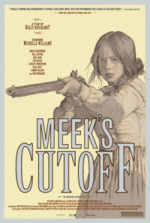 Meek’s Cutoff
Meek’s Cutoff 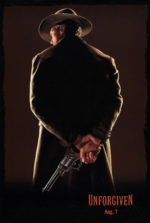 Unforgiven
Unforgiven 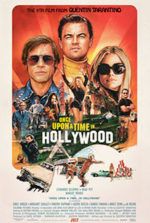 Once Upon a Time in Hollywood
Once Upon a Time in Hollywood